The robot servo drive types are those
Date:2020-05-27
As we all know, the structure of the robot is very complex, and the servo driver is one of the important parts of the robot, which affects the movement speed and accuracy of the robot. Robot designers in the selection of drivers must know the basic knowledge in advance, master the basic robot driver type, to make the right choice, together to understand the specific information.

Robot driver
Robot servo driver types are those:
Dc servomotor driver
Dc servomotor drivers mostly use pulse width modulation (PWM) servomotor drivers, by changing the pulse width to change the average voltage applied at both ends of the motor armature, so as to change the motor speed. PWM servo driver has the characteristics of wide speed range, low speed, fast response, high efficiency, strong overload capacity and so on. It is often used as dc servo motor driver in industrial robots.
Synchronous ac servo motor driver
Compared with dc servo motor drive system, synchronous ac servo motor drive has the advantages of high torque to inertia ratio, no brush and commutation spark, etc., which has been widely used in industrial robots.
In order to realize the current control of the three-phase permanent magnet synchronous servo motor (PMSM), a current-type pulse width modulation (PWM) phase inverter and a multi-loop control system with an inner loop of current and an outer loop of velocity loop are usually adopted in the drive of the synchronous ac servo motor. According to its working principle, driving current waveform and control mode, it can be divided into two servo systems:
Permanent magnet ac servo system driven by rectangular wave current and permanent magnet ac servo system driven by sine wave current.
Described above is the robot drive type, robots have strict request for driver to use, so the choice must consider the question, only to choose the appropriate drive, the robot can better play a role, if choose wrong parts, lead to robots in production failure, that thed loss outweights the gain.

Robot driver
Robot servo driver types are those:
Dc servomotor driver
Dc servomotor drivers mostly use pulse width modulation (PWM) servomotor drivers, by changing the pulse width to change the average voltage applied at both ends of the motor armature, so as to change the motor speed. PWM servo driver has the characteristics of wide speed range, low speed, fast response, high efficiency, strong overload capacity and so on. It is often used as dc servo motor driver in industrial robots.
Synchronous ac servo motor driver
Compared with dc servo motor drive system, synchronous ac servo motor drive has the advantages of high torque to inertia ratio, no brush and commutation spark, etc., which has been widely used in industrial robots.
In order to realize the current control of the three-phase permanent magnet synchronous servo motor (PMSM), a current-type pulse width modulation (PWM) phase inverter and a multi-loop control system with an inner loop of current and an outer loop of velocity loop are usually adopted in the drive of the synchronous ac servo motor. According to its working principle, driving current waveform and control mode, it can be divided into two servo systems:
Permanent magnet ac servo system driven by rectangular wave current and permanent magnet ac servo system driven by sine wave current.
Described above is the robot drive type, robots have strict request for driver to use, so the choice must consider the question, only to choose the appropriate drive, the robot can better play a role, if choose wrong parts, lead to robots in production failure, that thed loss outweights the gain.